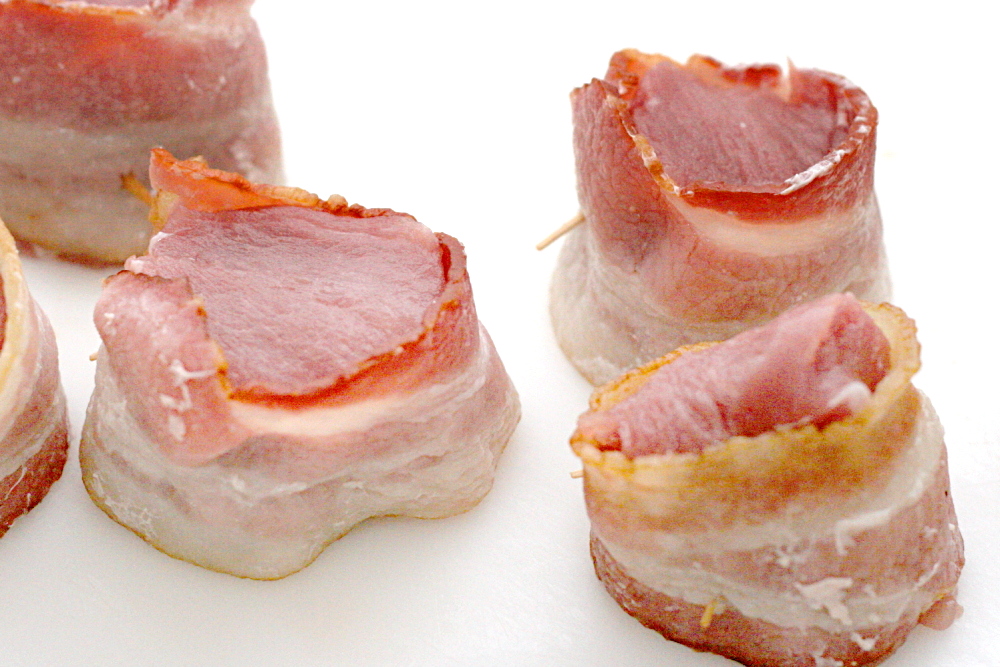 I almost never serve meals that consist of a meat, a starch, and a vegetable. This was never a conscious decision on my part; it was more of a slow realization. I’ve not sure why I don’t, but I think it’s because they’re usually more work. I tend to save meat-starch-vegetable meals for the weekend when I have more time. And when I do, I find it’s best to wrap the meat in bacon.
I almost never serve meals that consist of a meat, a starch, and a vegetable. This was never a conscious decision on my part; it was more of a slow realization. I’ve not sure why I don’t, but I think it’s because they’re usually more work. I tend to save meat-starch-vegetable meals for the weekend when I have more time. And when I do, I find it’s best to wrap the meat in bacon.
Okay, so this is the only meat I’ve ever wrapped in bacon. But I can’t deny that it made for some tasty pork tenderloin. Bacon makes everything better.
The recipe is not difficult at all. It only has a few ingredients, so it’s kept very simple. The only time consuming step was wrapping the bacon around the pork tenderloin medallions, but it takes less than a minute per medallion, and if you were serving this for guests, I don’t see any reason why that couldn’t be done ahead of time.
The tenderloin was, unsurprisingly as it’s wrapped in bacon, very good. However, next time I think I’ll brine it before cooking it, as maybe it was a little dry. (I might have overcooked it though – cooking big chunks of meat is probably my weakest skill in the kitchen.) The recipe is supposed to be served with a pan sauce, but somehow I missed that until too late. I didn’t miss it.
Bacon-Wrapped Pork Tenderloin Medallions (from Cooks Illustrated)
CI note: We prefer natural to enhanced pork (pork that has been injected with a salt solution to increase moistness and flavor), though both will work in this recipe. Begin checking the doneness of smaller medallions 1 or 2 minutes early; they may need to be taken out of the pan a little sooner.
12-14 slices bacon (1 slice for each pork medallion)
2 pork tenderloins (1 to 1¼ pounds each), trimmed of fat and silver skin, cut crosswise into 1½-inch pieces; thinner end pieces scored and folded
Kosher salt and ground black pepper
2 tablespoons vegetable oil
1. Place bacon slices, slightly overlapping, in microwave-safe pie plate and cover with plastic wrap. Cook in microwave on high power until slices shrink and release about 1/2 cup fat but are neither browned nor crisp, 1 to 3 minutes. Transfer bacon to paper towels until cool, 2 to 3 minutes.
2. Wrap each piece of pork with 1 slice bacon and secure with 2 toothpicks where ends of bacon strip overlap, inserting toothpicks on angle and gently pushing them through to other side.
3. Season pork with pepper. Heat oil in 12-inch skillet over medium-high heat until shimmering. Add pork cut side down and cook, without moving pieces, until well-browned, 3 to 5 minutes. Turn pork and brown on second side, 3 to 5 minutes more. Reduce heat to medium. Using tongs, stand each piece on its side and cook, turning pieces as necessary, until sides are well browned and internal temperature registers 145 to 150 degrees on instant-read thermometer, 8 to 14 minutes. Transfer pork to platter and tent lightly with foil; let rest 5 minutes, then serve.



































































